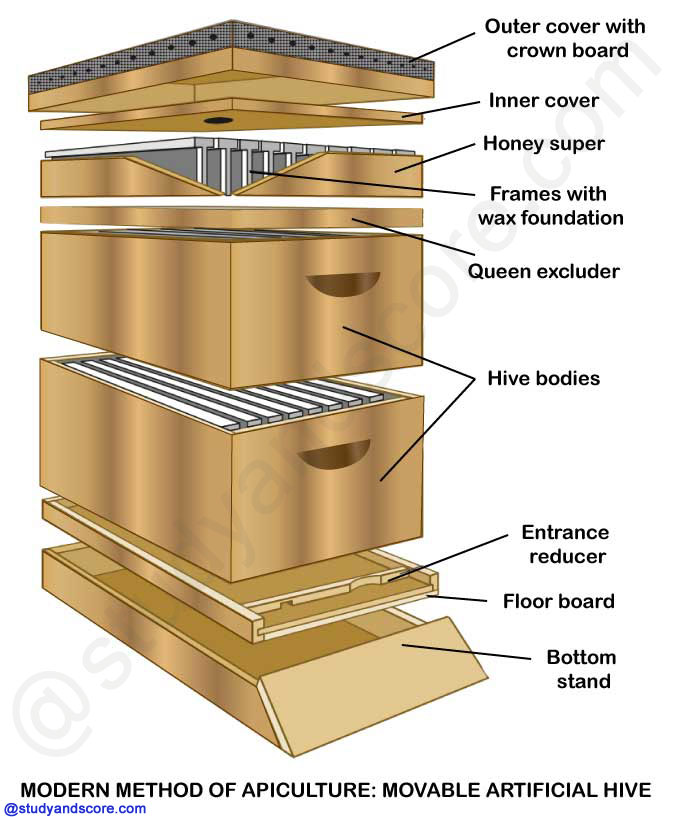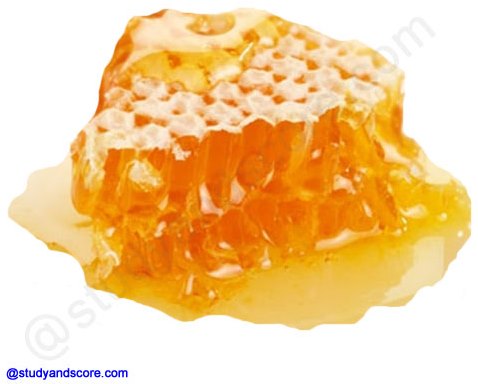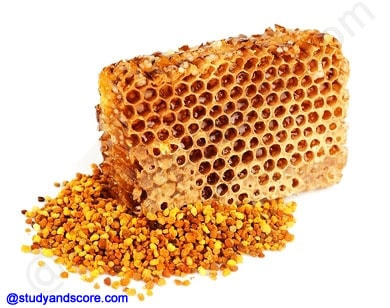Commercial production of honey is done by two methods, namely indigenous method and modern method. To obtain pure and more amount of honey modern methods of apiculture are in practiced.
1. Old or indigenous method
This is primitive and unplanned method of apiculture. In this method two types of hives are used,
In the indigenous method, the bees are first killed or made to escape from the hive with the help of smoke when the bees are at rest during night. This method has many drawbacks and it is not suitable for commercial large-scale production of honey. The following are the disadvantages of indigenous method:
Though the indigenous method has many drawbacks, it still persists.
2. Modern method
In the modern method of apiculture the honey bees are reared in movable artificial hives. This was designed and invented by Longstroth in 1951. This invention has turned apiculture into a cottage industry and has provided employment to lakhs of people.
The modern beehive is made up of a series of square boxes without tops or bottoms, set one above the other. These hives have a floor board and a bottom stand at the bottom and a crown board at the top. Inside these boxes, frames are vertically hung parallel to each other. The frames are filled with sheets of wax foundation on which the combs are built by the bees.

The entrance of the hive can be reduced with the help of the entrance reducer. The queen is usually confined to the brood chamber. The boxes termed honey supers are used for storage of honey. The queen is prevented from going to honey supers by the queen excluder that allows only the workers to move.
The following are the steps included in apiculture or commercial production honey
Catching a swarm: Swarm is an old queen accompanied by huge population of workers flying to start a new hive. The swarm is generally collected with a straw basket called as skep with a lid.
Hiving a Swarm: It is the process in which the collected swarm is transferred to the hive to build up the colony and produce honey.
Initial feeding: After the hiving of the swarm, they are fed with sugar syrup. This feeding will help the bees to settle down to work in their new home.
Starting the work: After settling down in the new hive the bees start to work in their respective job roles in the new hive. The worker bees move about in the surrounding flora collecting nectar and pollen. Consequently the colony expands and starts the production.
The two main products from a bee hive are honey and wax which are valuable and marketable commodities.
Honey
Honey is the most important product of apiculture. It is a food material for bees and their larvae. The bee hive stores large quantities of honey to meet the demands in scarcity. Chemically, honey is a sticky water solution of sugar.
However, composition of honey and its different flavours depend on the kinds of flowers from which the nectar is collected. Nectar is sucked from flowers and mixed with saliva. It is swallowed into a special region of the gut called honey stomach.
Nectar is a disaccharide (sucrose) it is hydrolysed by the salivary amylase to produce monosaccharides (fructose and glucose). Inside the hive the workers regurgitate the processed nectar. The honey thus produced is still very dilute.
After placing this honey onto the storage cells of the hive the bees “fan” with their wings to evaporate the excess water and bring the honey to its required concentration. Extraction of honey from the combs is done by the method of centrifugation.

Uses of Honey: Some uses of honey are as follows,
Honey is a nutritious food, rich in energy and vitamins. Our body readily absorb sugar, minerals, vitamins and other materials from honey.
Beeswax
Generally bees consume about 10-20 kg of honey to produce one kg of bee wax. Beeswax is secreted by the wax glands located on the underside of the last four abdominal segments of the worker bee. This wax is used by the bee in constructing bee combs in which the colony of the bees develops.

Uses of beeswax: Some uses are as follows,

Discuss the process of production of honey through old method.
Explain the commercial productin of honey with modern method.
Mention the steps included in the commercial production of honey.
What are the main products from an apiary?
Write the uses and the composition of honey.
- Share with your friends! -
Login to post your comment here...
- or with social Account -